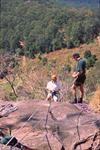 Adventure Tourism is a term which is not easily defined. Different people have different ideas of what is “adventure”. For one person, “adventure” may be something as simple as camping outside in a tent, or walking through a wilderness area for an hour. For another, this would be considered passive tourism, whereas adventure would mean participating in dangerous and physically (also maybe emotionally) challenging activities, such as climbing a sheer rock face or white water rafting in dangerous rapids.
Adventure Tourism is a term which is not easily defined. Different people have different ideas of what is “adventure”. For one person, “adventure” may be something as simple as camping outside in a tent, or walking through a wilderness area for an hour. For another, this would be considered passive tourism, whereas adventure would mean participating in dangerous and physically (also maybe emotionally) challenging activities, such as climbing a sheer rock face or white water rafting in dangerous rapids.
Even for those tourists seeking challenging experiences, the degree of challenge desired may be quite different. Some will balk at undertaking potentially dangerous activities like walking on a rope bridge across a deep ravine, and find a trek through the jungle at ground level sufficiently challenging. Some will find another’s ‘adventure’ decidedly unpleasant, disagreeable, foolishly reckless, traumatic or boring.
Therefore, the first principle of adventure tourism is catering for difference: different expectations, different physical abilities, different likes and dislikes, and different psychological make-ups.It is not a matter of making an adventure less adventurous, or more exciting; nor is it a matter of participants’ ‘inferior’ or ‘superior’ physical or psychological resilience. It is simply a matter of personal difference.
Most adventure tourism takes place outdoors in natural settings, such as rivers, oceans, cliffs, forests, snowfields, and caves. Being outdoors heightens the sense the tourist is ‘getting away from it all’. Natural attractions provide the perfect venue for many adventure activities – the cliff, river, or other natural feature – has an inherent element of adventure. Moreover, the attraction is ‘free’ (i.e. the tourist operator does not have to pay to create the attraction).
The remote location of many adventure tourist destinations can present problems:
- Facilities are more costly to develop and maintain.
- Staffing can be a problem, as staff often do not wish to live a long way from schools, shops, social opportunities, etc.
- There may be limited transport services and access roads to the facility.
- Supporting facilities such as medical services, shops etc are usually limited.
- Land use restrictions are likely to be more stringent than those in developed areas, which mean visitor numbers, tourist activities, and building development will be subject to tight planning regulations.
- Many wilderness areas are in environments that experience climatic extremes (e.g. monsoons or cyclones, heavy winter snows, extreme summer heat), which means that visitor numbers fluctuate dramatically throughout the year. In some areas, operations close during the ‘off’ season.
A new trend in adventure tourism is the development of artificial adventure environments. Artificial adventure environments are re-creations based on ‘real life’ adventures, for example, indoor climbing walls are simulated to look like cliff faces. Some advantages to providing artificial adventure environments are:
- They can be located in towns and in popular tourist destinations so people do not have to travel far to get to them.
- They are comparatively safe environments compared to the ‘real thing’.
- Indoor facilities can stay open all year round, regardless of the weather. They can also operate at night, so that many more participants are able to use the facilities.
Indoor climbing walls are the best known indoor adventure environments but there are others. Reefs, beaches, snowfields, ice walls, caves, and slalom white-water rafting courses are just some of the artificial environments that have been developed for adventure tourists.
Ask about our Adventure Tourism Course -train to work in adventure tourism.
